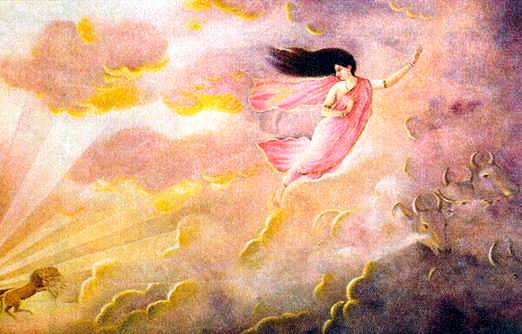Nachiketas - Introduction to Katha Upanishad

Usha, the Dawn
the luminous Emergence that the Aryan forefathers worshipped
Introduction to the Katha Upanishad
The Katha Upanishad contains secret knowledge of the soul and the self, which has been described in terms that evoke a sense of authenticity and assured experience.
The Upanishad contains two cycles, each having three chapters. The first chapter of the first cycle narrates the story of the offering of Nachiketas by his father in a fit of anger to Yama, Lord of death, and the bestowing of three boons to Nachiketas by Yama. It also covers the account of the boons asked by Nachiketas, and we are told that while the first two boons are granted readily, the third boon asked by Nachiketas is so very special that Yama tries his best to dissuade him from pressing for it. Nachiketas, however, remains firm and shows the courage of refusing to yield to the highest temptations of worldly pleasure. He repeats his boon in unequivocal terms.
In the second chapter, we find Yama granting him the third boon and expounding the secret of the Supreme Reality behind the universe, and of the realization of that Reality by sacrificing all worldly things, which are momentary. Yama also explains the symbolism of OM. This chapter ends with the description of the immortality of the Unborn Supreme Reality.
The third chapter deals with the secret knowledge of the celestial Fire (Agni), its relationship with the evolution of man, his inner soul, and the relationship between soul, intellect, mind and senses.
The first chapter of the second cycle describes the complex relationship between the Supreme Reality, the divine creative
Mother (Aditi), the individual soul Jiva), and the inner soul, which is described poetically as 'no bigger than the thumb.'
The second chapter of this cycle describes what happens to man after the death of his body, and explains the immortality of the soul, which has continuity of the past, present and the future. This chapter ends with the description of the nature of the Eternal and its surpassing luminosity.
The last chapter describes the totality of Reality as an eternal Ashwattha-tree whose root is above, but branches are downward. It also describes the interrelationship of the senses, mind, the inner soul (antaratma), and the Supreme Reality. It declares:
The mind is higher than the senses, and higher than the mind is the genius, above the genius is the Mighty Spirit, and higher than the Mighty One is the Unmanifested. But highest above the Unmanifested is the Purusha who pervades all and alone has no sign nor feature. Mortal man knowing Him is released into immortality.1
The last few verses give the secret of the Yoga by means of which one can arrive at the God-knowledge, soul-knowledge, and world-knowledge. These verses are so memorable that they can be quoted in full:
One must apprehend God in the concept 'He Is' and also in His essential: but when he has grasped Him as the 'Is', then the essential of God dawns upon a man.
"When every desire that finds lodging in the heart of man, has been loosened from its moorings, then this mortal puts on immortality: even here he tastes God, in this human body.
_________
1. Sri Aurobindo, The Upanishads, SABCL, Vol. 12, p. 263
Yea, when all the strings of the heart are rent asunder, even here, in this human birth, then the mortal becomes immortal. This is the whole teaching of the Scriptures.
A hundred and one are the nerves of the heart, and of all these only one issues out through the head of a man: by this his soul mounts up to its immortal home, but the rest lead him to all sons and conditions of birth in his passing.
The Purusha, the Spirit within, who is no larger than the finger of a man is seated for ever in the . heart of creatures: one must separate Him with patience from one's own body as one separates from a blade of grass its main fibre. Thou shall know Him for the Bright Immortal,, yea, for the Bright Immortal.2
The story of the dialogue between Yama and Nachiketas ends here, and we are told:
Thus did Nachiketas with Death for his teacher win the God-knowledge: he learned likewise the whole ordinance of Yoga: thereafter he obtained God and became void of stain and void of death. So shall another be who comes likewise to the Science of the Spirit.3
*
* *
________
2. Ibid., pp. 264-65.
3. Ibid., p. 265.
Related Books
- Alexander the Great
- Arguments for The Existence of God
- But it is done
- Catherine The Great
- Danton
- Episodes from Raghuvamsham of Kalidasa
- Gods and The World
- Homer and The Iliad - Sri Aurobindo and Ilion
- Indian Institute of Teacher Education
- Joan of Arc
- Lenin
- Leonardo Da Vinci
- Lincoln Idealist and Pragmatist
- Marie Sklodowska Curie
- Mystery and Excellence on The Human Body
- Nachiketas
- Nala and Damayanti
- Napoleon
- Parvati's Tapasya
- Science and Spirituality
- Socrates
- Sri Krishna in Brindavan
- Sri Rama
- Svapnavasavadattam
- Taittiriya Upanishad
- The Aim of Life
- The Crucifixion
- The Good Teacher and The Good Pupil
- The Power of Love
- The Siege of Troy
- Uniting Men - Jean Monnet